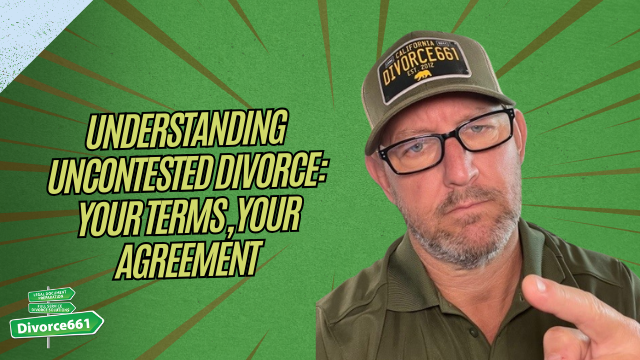Understanding Uncontested Divorce: Your Terms, Your Agreement
Divorce can be a challenging experience, but it doesn’t have to be a battle. If you and your spouse are in agreement about the terms of your separation, you have the power to shape your divorce to suit your needs. This blog dives into the essential aspects of an uncontested divorce, emphasizing that you and your spouse decide the terms—not the court. Let’s explore how to navigate this process smoothly and amicably.
What is an Uncontested Divorce?
An uncontested divorce is one where both parties agree on all the major issues such as custody, child support, alimony, and the division of assets and debts. This type of divorce is often less stressful and can be resolved more quickly than contested divorces, where disagreements lead to lengthy court battles.
Setting the Terms
One of the most significant advantages of an uncontested divorce is that you and your spouse can decide the terms of your marital settlement agreement. Here are some of the critical areas where you have control:
- Custody Arrangements: You can determine who the children will live with and how visitation will be handled.
- Child Support: You can decide on the amount and duration of child support payments.
- Alimony: You can agree on whether one spouse will pay alimony and, if so, how much and for how long.
- Asset and Debt Division: You can decide how to divide your marital assets and debts, including property, bank accounts, and other financial obligations.
Why Choose an Uncontested Divorce?
Choosing an uncontested divorce can offer several benefits:
- Cost-Effective: An uncontested divorce typically costs less than a contested one due to reduced legal fees and court costs.
- Faster Resolution: The process can often be completed more quickly, allowing both parties to move on with their lives.
- Less Stressful: By avoiding court battles, you can reduce the emotional turmoil often associated with divorce.
- Control Over Outcomes: You and your spouse have the final say on all terms, which can lead to more satisfactory resolutions.
Common Concerns and Misconceptions
Many people worry that the court will impose terms regarding child support or asset division in an uncontested divorce. However, this is not the case. If both parties agree on the terms, the court will typically honor that agreement. Here are some common misconceptions:
- The Court Decides Everything: This is false. You have the freedom to negotiate and agree on terms.
- Child Support is Mandatory: While child support is often necessary, the amount can be negotiated between you and your spouse.
- Equal Division of Assets is Required: You can agree to any division of assets and debts that you both find fair.
Steps to Achieve an Uncontested Divorce
Here’s a step-by-step guide to help you through the process of obtaining an uncontested divorce:
- Discuss Terms: Have open discussions with your spouse about the terms you both agree on.
- Draft a Marital Settlement Agreement: Put all agreed terms in writing. This document will outline custody, support, and division of assets.
- File for Divorce: Submit the necessary paperwork to the court. This typically includes your divorce petition and the marital settlement agreement.
- Attend a Prove-Up Hearing: This is a short court appearance where a judge finalizes the divorce. You’ll need to present your agreement.
- Obtain Your Final Decree: Once the judge approves your agreement, you will receive a final decree of divorce, officially ending your marriage.
Preparing for the Prove-Up Hearing
The prove-up hearing is a crucial step in finalizing your uncontested divorce. Here’s what you need to know to prepare:
- Documentation: Bring all necessary documents, including your marital settlement agreement and any required affidavits.
- Understand the Questions: Be prepared to answer basic questions from the judge regarding your agreement and the terms you’ve set.
- Stay Calm: Remember, this is a routine process. Judges typically understand the emotional weight of divorce and are there to help facilitate the finalization.
Common Questions and Answers
Here are some frequently asked questions about uncontested divorces:
- Do I need a lawyer for an uncontested divorce? While not mandatory, having a lawyer can help ensure that your agreement is fair and legally sound.
- How long does the process take? An uncontested divorce can sometimes be finalized in as little as 30 days, depending on court schedules.
- What if my spouse doesn’t agree on terms? If you cannot reach an agreement, the divorce may become contested, and you will need to go through a more complex legal process.
Conclusion
An uncontested divorce offers a pathway to a more amicable separation, allowing you and your spouse to decide the terms that best suit your situation. By understanding the process, preparing adequately, and maintaining open communication, you can navigate this chapter of your life with less stress and more control. Remember, the court will honor the agreements you both establish, so take the time to discuss and negotiate terms that work for both of you.
In the end, an uncontested divorce can pave the way for a smoother transition into the next phase of your life—one where you can move forward with clarity and peace of mind.

